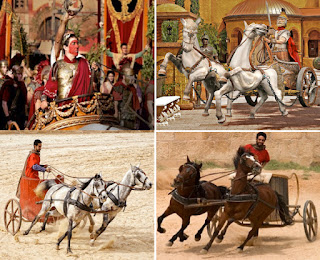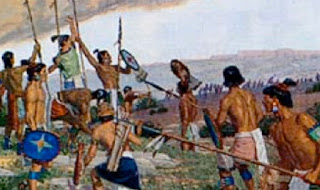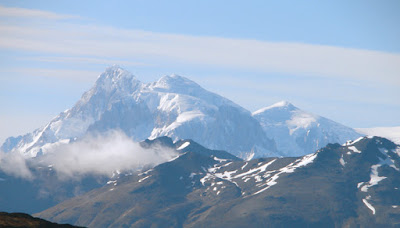Continuing with the article we have been taking this information from to show how Mesoamericanists' use normal translation problems and try to apply them toward the Joseph Smith translation of the Book of Mormon. In this post, we will finalize the normal translation process, and in the following post, show how the Joseph Smith translation is different and does not fall into the problems associated with these normal translation difficulties.
As an example, in normal translation, such things as “chariot,” as used in the scriptural record could run into difficulties since the Welsh cognate to the English chariot, signifies, among other things, a “dray”–which Webster’s defines as “any of several wheelless land vehicles used for haulage,” and for which it gives as a synonym nothing less than travois; dray is obviously cognate with the verb to drag–or a “sledge” (which term is, itself, related to words like sleigh and sled–which also plainly denote wheelless vehicles).
(Interjectory note: In the 1828 dictionary, the word “dray” meant: “A low cart or carriage on wheels, drawn by a horse,” or “a sled.” In modern definitions, “dray” means a truck or car or vehicle used to haul goods, especially a strong cart or wagon without sides.” Neither of these two definitions, or the word “dray” relates to the scriptural record in the Book of Mormon, which strongly suggests the carrying of people).
Horses pulling drays, which is any cart, typically flatbed, meant to haul material, equipment, food, etc. There is no connection between a dray and a chariot
Continuing with the article: The English word “chariot” comes from Latin carrus, car, and is etymologically related to the verb to carry. The primary definition for chariot seems to be a device to carry some sort of load. We should not automatically assume that the Nephites understood chariots as wheeled war machines. Because no Book of Mormon verse says or suggests that chariots are mounted, dismounted, or that they carried people or were ridden (although this could be inferred from a twenty-first century view), we cannot say for certain what a Book of Mormon “chariot” means.
(Interjectory note: The verb transitive is “to convey in a chariot.” And since the scriptural record shows that a chariot is not used singularly, but in conjunction with horses, as in “that they should prepare his horses and chariots, and conduct him forth to the land of Nephi” (Alma 18:9), also “preparing his horses and his chariots” (Alma 18:10); also, “ready the horses and the chariots for the king and his servants” (Alma 18:12); also “caused that his servants should make ready his horses and his chariots” (Alma 20:6). It would seem obvious that these chariots conveyed people, such as king Lamoni and Ammon)
Continuing: Native American kings, for example, were often carried into war or to ceremonial events on litters or palanquins. These were sedans carried on the shoulders of other men and certainly fits the Hebrew definition of a “chariot.” The Book of Mormon, it must also be noted, never mentions horses “pulling” chariots.
(Interjectory note: The 1828 American Dictionary of the English Language, which we have used for several years now to better understand and define the words that would have been known to Joseph Smith in his 1829 translation of the plates, gives the following meaning to the word “chariot.” As for the translation indicating chariot is from the word “car,” the 1828 dictionary defines “car” as: “A car or vehicle used formerly in war, drawn by two or more horses, and conveying two men each. These vehicles were sometimes armed with hooks or sythes,” which is a clear description of a chariot. The 1828 dictionary also gives “A small vehicle moved on wheels, usually drawn by one horse,” as the meaning for the word “car,” and also “Any vehicle of dignity or splendor; a chariot of war or of triumph.”)
Horse-drawn sled
Continuing: But if Nephite chariots were not wheeled (and
it’s possible that they were), why are chariots mentioned in conjunction with
Nephite “horses”? First, Nephite chariots (wheeled or not) may have been pulled
by deer or tapirs (which may have been included in the Nephite term “horse”). (Interjectory note: There is no reason to even suggest that these Nephite or Lamanite chariots were pulled by anything other than horses. As shown above in several scriptures, the words “horse” and “chariot” are used together. To try and claim “horse” didn’t mean “horse” is to throw a deleterious or adverse image upon the entire Joseph Smith translation process, which we will cover in the next post)
Continuing: Several ancient Eastern and Near Eastern pieces of art and petroglyphs depict chariots drawn by deer. Early Hindus had chariots pulled by deer. We find deer-pulling chariots in Asian art. The Greek goddess Artemis supposedly rode a chariot pulled by deer.
(Interjectory note: In almost every study where deer are associated with chariots, wagons or carts, it is in connection with gods and goddesses, nymphs, leprechauns, and the like, or as a symbol of something, like in the painting Triumph of Time, showing Father Time based on an allegorical poem, 14th century. Very seldom in art is there a realistic use of a deer pulling a cart of any kind. The images found had to do with myths and legends, of gods and goddesses, of poems and verse. No doubt, such can be found somewhere, but the suggestion is simply that it would have been extremely rare, if at all, since the hundreds found show only a connection with deity).
Continuing: Perhaps deer or tapirs pulled wheelless chariots. We know, for instance, that the American Indian travois (a kind of sled) was pulled, not only by horses, but also by dogs.
(Interjectory note: Sled dogs were and are used in the far north because of the snow conditions. Horses and just about any other type of animals would sink into the snow drifts, making movement difficult and slow. Dogs, on the other hand, because of their light weight and soft paws actually can walk or run on the snow’s surface—they are the only animal that can do so. Not until the invention of the snowmobile in the 1950s and 1960s did away with commercial use of dogsleds, like in delivering mail, but the Eskimos or Inuits still use them to great advantage. It never had anything to do with language or horses, or anything else other than the dog’s ability to travel over snow economically and with good speed).
Continuing: Maybe King Lamoni used a deer or tapir-drawn travois to cart his supplies while traveling. The mass Nephite movement to Zarahemla certainly suggests that chariots were used to carry supplies rather than soldiers.
(Interjectory note: When and how chariots were used other than the few references we have is unknown to us. What use in war, if any, they had is also unknown. To speculate on it serves no purpose).
Continuing: “It’s also possible that Nephite “horses”–at least when associated with chariots–were among the provisions that King Lamoni needed during his travels (we know that horses were part of the provisions which the Nephites reserved for themselves when fighting the Gadianton Robbers [3 Nephi 4:4]). Perhaps “preparing” the horses and chariots would be like “preparing the chicken and backpack.” To modern ears this doesn’t suggest that the chicken will carry the backpack but rather than a chicken meal will be prepared to go in the backpack. If Book of Mormon horses were eaten, they may have been one of the provisions loaded on a “chariot” and carried or dragged by men.
(Interjectory note: This is both silly and uneducated dribble! Can it be possible that the Lamanites groomed and prepared their horses and chariots so they could eat the horses on the way? King Laman and Ammon were not going to the other end of the world—they were traveling into the next land. While they might have taken food for the journey, it seems rather ridiculous to suggest they took “horses” to tide them over for their evening meal).
(See the next post, “An Interesting Thing About Translation – Part VI,” for an understanding between normal translation and that type of translation accomplished by Joseph Smith in the Book of Mormon—the difference, though seemingly lost on the theorists make all the difference in the world in understanding the translation and accuracy of the Book of Mormon)

































